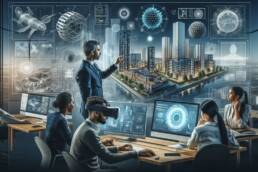Innovative 3D render tech is not just a tool; it’s a revolution in the real estate industry. With the introduction of this game-changing technology, realtors now possess the dream maker for property marketing. This tech enables vivid, immersive virtual tours, allowing clients to visualize and connect with properties on a deeper level. It’s a leap forward in showcasing real estate potential, significantly enhancing buyer experience and satisfaction.
Innovative 3D render tech is not just a tool; it’s a revolution in the real estate industry. With the introduction of this game-changing technology, realtors now possess the dream maker for property marketing. This tech enables vivid, immersive virtual tours, allowing clients to visualize and connect with properties on a deeper level. It’s a leap forward in showcasing real estate potential, significantly enhancing buyer experience and satisfaction.
Key Takeaways
- Architectural rendering offers a more realistic and detailed preview of properties, attracting high-income buyers and investors.
- Commercial rendering integrates with architectural design, highlighting the potential of retail and office spaces within developments.
- The complexity of commercial rendering projects presents both challenges and opportunities for architects and developers.
- Economic and environmental implications of commercial rendering influence decision-making in real estate development.
- Technological advancements in commercial rendering have transformed the way properties are marketed, providing a more immersive and interactive experience for potential buyers.
The Evolution of Commercial Rendering in Real Estate

1. Historical Perspective on Commercial Rendering
The evolution of technology has transformed the way properties are marketed. Traditional real estate marketing methods have certain limitations that architectural rendering addresses by offering a more dynamic and immersive experience. Flat photographs and basic floor plans often cannot convey the true essence of a property, but architectural rendering provides a more realistic and detailed preview.
To illustrate the impact of architectural rendering, consider these examples:
2. Technological Advancements in Commercial Rendering
The field of architectural rendering is continuously evolving, with technological advancements enhancing its effectiveness. Integrating VR with rendering allows for immersive property tours, where buyers can explore properties virtually in a more interactive way. Advances in software have enabled the development of detailed 3D visualizations, which have become an essential aspect of designing and marketing these corporate spaces. This article highlights ten key benefits of employing business center rendering in the development of corporate facilities. 1. Realistic Visualization of Business Center Designs Business center rendering provides highly realistic and detailed visualizations of proposed.
3. Impact of Commercial Rendering on Real Estate Marketing
The evolution of technology has transformed the way properties are marketed. Traditional real estate marketing methods have certain limitations that architectural rendering addresses by offering a more dynamic and immersive experience. Flat photographs and basic floor plans often cannot convey the true essence of a property, but architectural rendering provides a more realistic and detailed preview.
Architectural rendering is creating digital representations of properties, often using sophisticated software. From realistic textures to lighting, these renderings enable a comprehensive exploration of interior spaces, providing a preview of the ambiance and functionality of the designed interiors.
Real estate rendering, incorporating both interior and exterior perspectives, is a multifaceted tool that significantly enhances the marketing impact of architectural projects. 3D artists contribute to the creation of visually compelling content that attracts potential buyers, investors, and real estate professionals. These renderings become instrumental in conveying the unique selling points of a property, setting a new standard for property marketing.
- Implement a table for presenting structured, quantitative data. Ensure it’s succinct and formatted correctly in Markdown.
- Use a bulleted or numbered list for less structured content, like steps, qualitative points, or a series of related items.
Architectural rendering offers a transformative approach to property marketing, providing a more immersive and engaging experience for potential buyers and investors.
Challenges and Opportunities in Commercial Rendering

1. Complexity of Commercial Rendering Projects
The complexity of commercial rendering projects presents a multifaceted landscape that demands meticulous attention to detail and strategic coordination. Managing complexity in 3D visualization projects requires a focus on efficiency, enhanced realism, and clear communication. Advanced tools and AI algorithms help overcome technical limitations and streamline workflows. To create 3D visualizations, three specialists are needed: a project manager, a 3D artist, and a post-production artist. The complexity of the project and the scope of work are influenced by such factors as the level of detail, unique elements, and their number, texturing of models, etc. In addition, the type of post-processing is also essential, which may vary from project to project. In some cases, careful detailing is necessary, while retouching and color adjustments are sufficient in others. Here are some aspects that have the greatest impact on the final cost of rendering services:
- Project Complexity: The level of detail, unique elements, and their number, as well as the texturing of models, significantly influence the scope of work and the final cost.
- Type of Post-Processing: The post-processing requirements vary from project to project, affecting the overall cost and time investment.
- Project File Size: High-quality, detailed visualizations require more time and computing power, contributing to higher costs.
- The Time of Rendering: The complexity and level of detail in the visualization directly impact the duration of the rendering process.
These factors underscore the intricate nature of commercial rendering projects and emphasize the need for a comprehensive approach to project management and resource allocation. As industry professionals, we recognize the significance of addressing these complexities with precision and expertise, ensuring the delivery of exceptional results. Our commitment to excellence and proficiency enables us to navigate the challenges of commercial rendering, providing our clients with unparalleled value and innovation. Contact us today to explore how our specialized services can elevate your architectural projects to new heights.
2. Integration of Commercial Rendering with Architectural Design
Commercial rendering plays a crucial role in enhancing the presentation and sale of architectural projects. By integrating commercial architectural 3D visualization with architectural design, architects can effectively convey their design concepts and create compelling narratives that resonate with potential buyers. This collaborative approach aids architects in attracting key stakeholders and conveying the commercial viability of their designs. The transformative impact of 3D artists in elevating the presentation and sale of new construction homes reinforces the collaborative spirit that drives innovation in the architectural and real estate industries. In addition, the value of 3D visualization includes creating a positive first impression, more accurate drawings and presentations, and the digitization of real estate objects. This clarity enhances the communication of project details to a broader audience. Furthermore, tailored renderings appeal to businesses and investors by highlighting functional aspects and the unique selling points of commercial spaces. This approach not only enhances the visual integration of architectural design but also establishes authority in the real estate market. To summarize, the integration of commercial rendering with architectural design is a game-changer in marketing new construction homes and commercial spaces.
3. Economic and Environmental Implications
The complex interplay between commercial rendering and real estate financing can pose a significant financing challenge, prompting a reliance on private financing sources that carry higher costs and stricter terms. This interdependence highlights the mutual influence of these two sectors. As the industry continues to evolve, its partnership with commercial real estate seems poised to flourish, bringing new opportunities and innovations. However, the relationship also faces ongoing challenges in navigating legal frameworks, zoning constraints, and financing limitations. Ultimately, the future of this union will depend on forthcoming policy shifts.
- Implement a table for presenting structured, quantitative data. Ensure it’s succinct and formatted correctly in Markdown.
- Use a bulleted or numbered list for less structured content, like steps, qualitative points, or a series of related items.
The relationship between commercial rendering and real estate financing is intricate and requires careful navigation to leverage opportunities and overcome challenges.
In the world of commercial rendering, there are numerous challenges and opportunities that businesses face. From creating photorealistic visualizations to meeting tight deadlines, the demands of commercial rendering require expertise and creativity. At CG Viz Studio, we understand these challenges and see them as opportunities to showcase our skills and bring your visions to life. Our team is dedicated to delivering high-quality 3D rendering solutions that meet your specific needs. Whether you’re looking to enhance your architectural designs, product presentations, or marketing materials, we’re here to listen and create. Contact us today to discuss your ideas, questions, and projects. Let’s work together to turn your concepts into captivating visual experiences.
Get your project estimated within 60 minutes - simply send us your project brief!
Conclusion
In conclusion, Innovative 3D Render Tech: A Realtor’s Dream Maker. It offers a more dynamic, immersive, and realistic preview of properties, revolutionizing the way properties are presented to potential buyers and investors. The transformative impact of architectural rendering is evident in its ability to attract high-income buyers, showcase the potential of commercial spaces, and empower real estate professionals in effectively presenting and promoting architectural projects. With its advanced technology and artistic flair, architectural rendering is elevating the marketing impact of real estate, making properties more appealing and accessible to a wider audience.
Frequently Asked Questions
Architectural rendering is the creation of digital representations of properties using sophisticated software and advanced technology to provide a realistic and detailed preview of buildings and spaces.
Architectural rendering enhances real estate marketing by offering a more dynamic and immersive experience compared to traditional methods. It provides a more realistic and detailed preview of properties, making them more appealing and accessible to a wider audience.
The benefits of using architectural rendering in real estate include attracting potential buyers, investors, and real estate professionals, conveying the unique features and value propositions of properties, and empowering marketing collaborations with realtors.
3D rendering enhances property presentations by providing high-definition, detailed, and interactive representations of properties. It allows for immersive property tours and personalized experiences for viewers.
3D artists play a pivotal role in architectural rendering by creating visually compelling content that attracts potential buyers, investors, and real estate professionals. They empower architects by providing realtor renderings and aid in effectively presenting and promoting architectural projects.
Yes, architectural rendering can be used for commercial real estate to attract investors and tenants, showcasing the potential of retail and office spaces within developments, and highlighting the functional aspects and unique selling points of commercial spaces.



